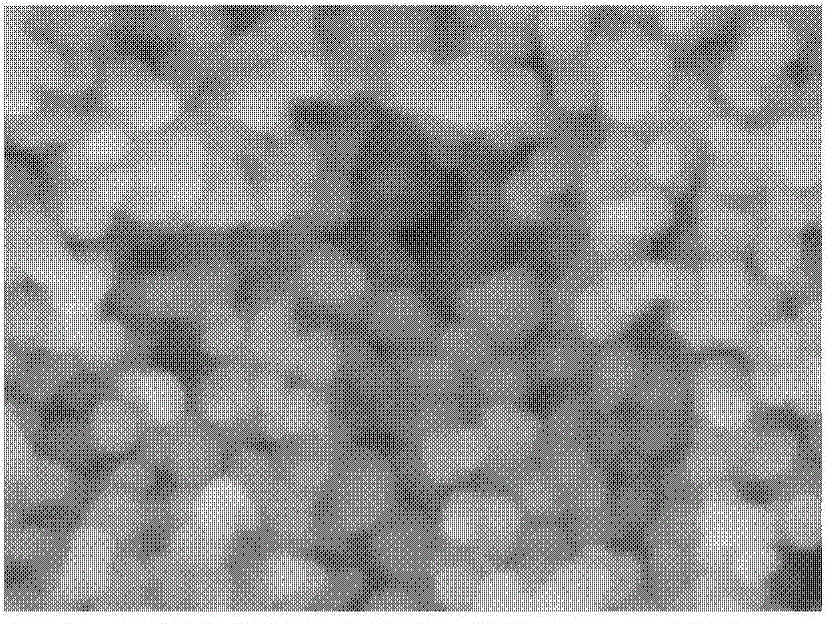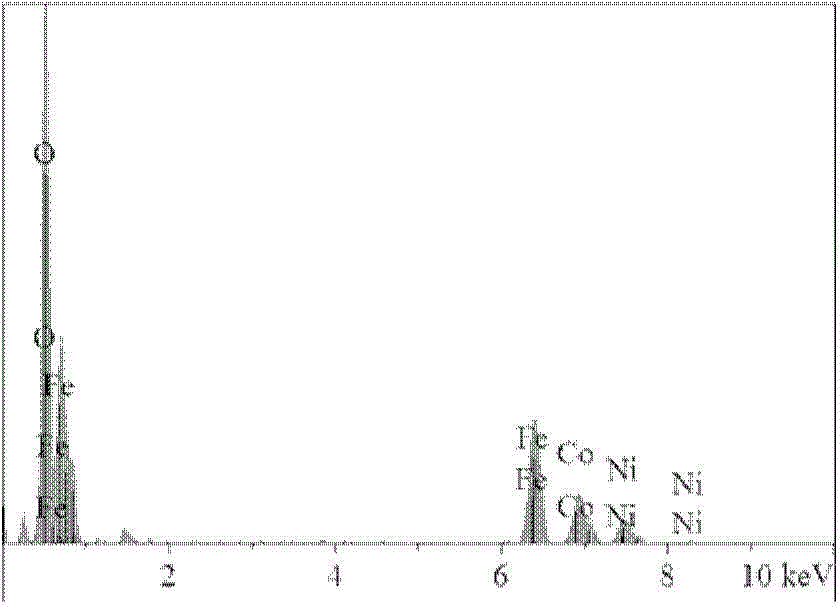Ni-Co-Fe three-component composite nanometer metal oxide, preparation method thereof and application thereof
A nano-metal, ternary composite technology, applied in metal/metal oxide/metal hydroxide catalysts, chemical instruments and methods, chemical/physical processes, etc., can solve problems such as being easily poisoned by chlorine, and achieve easy recycling, The preparation method is simple and easy, and the effect of low reaction temperature
- Summary
- Abstract
- Description
- Claims
- Application Information
AI Technical Summary
Problems solved by technology
Method used
Image
Examples
preparation example Construction
[0029] The method for preparing the above-mentioned nickel-cobalt-iron ternary composite nano metal oxide provided by the present invention, its main steps are:
[0030] 1) Dissolve nickel salt, cobalt salt and iron salt in the corresponding amount of aqueous solution, add a certain amount of urea (urea) at the same time, after stirring evenly, transfer the solution to a hydrothermal reaction kettle for a period of time, and wait for the solution to cool to At room temperature, the precipitate was collected; the precipitate was washed with distilled water and centrifuged, and dried in an oven to obtain the precursor of nickel-cobalt-iron ternary composite nano-metal oxide;
[0031] In step 1: the molar ratio of nickel, cobalt and iron is 0.5-2:0.5-2:1-4. Nickel salt, cobalt salt and iron salt are all one of nitrate, sulfate, chloride salt, etc., add 1- 8g of urea, after stirring evenly, transfer the solution to a 25-100mL stainless steel reactor, and react at 150-250°C for 6-...
Embodiment 1
[0038] Take Ni(NO 3 ) 2 ·6H 2 O 0.1454g, Co(NO 3 ) 2 ·6H 2O 0.1455g, Fe(NO 3 ) 3 9H 2 O0.808g, 2.0g of urea and 40mL of distilled water were placed in a 100mL beaker, stirred electromagnetically at room temperature to become a transparent liquid, and transferred to a 50mL stainless steel reaction kettle. The reactor was placed in a muffle furnace and reacted at 180°C for 10h. After the reaction was completed, it was cooled to room temperature, and the black precipitate was collected. The precipitate is washed and dried at 100° C. for several hours to obtain a precursor of black nickel-cobalt-iron ternary composite nano metal oxide. The precursor was fired at 350°C for 3 hours in a tube furnace with air flow at ~60mL / min, and the target product was a black powder of nickel-cobalt-iron composite oxide. The results of SEM, EDX and magnetic characterization are shown in Figure 1. Figure 1a The SEM characterization results show that the prepared material is a spherical na...
Embodiment 2
[0040] The product of embodiment 1 is taken by weighing 50mg and in quartz tube, the generation concentration of monochlorobiphenyl (CB 1) is 40ppm, and reaction atmosphere is 20vol.%O of 40mL / min 2 / N 2 The mixed gas (gas standard substance) and 40mL / min N 2 (gas standard substance). Firstly, it was adsorbed at 100°C for 1 h. After the adsorption was saturated, the reaction temperature was gradually increased to 350°C at intervals of 50°C. Each temperature point was stable for 0.5 h. The concentration of CB 1 before and after the reaction was measured online by gas chromatography. When the reaction temperature rose to 350°C and remained stable for 0.5h, the temperature was lowered to 100°C, and then gradually raised to 350°C. Test its degradation activity to CB 1 continuously on the same material in such a cycle for 5 times, the results are as follows: Figure 2a shown. It can be found that in the early stage of the reaction, the nickel-cobalt-iron ternary composite nano-...
PUM
| Property | Measurement | Unit |
|---|---|---|
| particle diameter | aaaaa | aaaaa |
| particle diameter | aaaaa | aaaaa |
| particle diameter | aaaaa | aaaaa |
Abstract
Description
Claims
Application Information
 Login to View More
Login to View More - R&D
- Intellectual Property
- Life Sciences
- Materials
- Tech Scout
- Unparalleled Data Quality
- Higher Quality Content
- 60% Fewer Hallucinations
Browse by: Latest US Patents, China's latest patents, Technical Efficacy Thesaurus, Application Domain, Technology Topic, Popular Technical Reports.
© 2025 PatSnap. All rights reserved.Legal|Privacy policy|Modern Slavery Act Transparency Statement|Sitemap|About US| Contact US: help@patsnap.com



